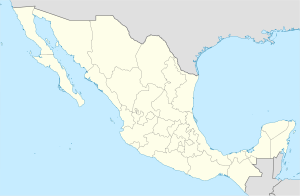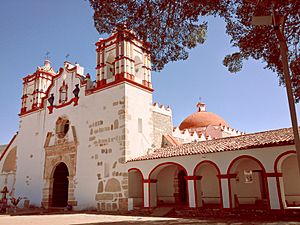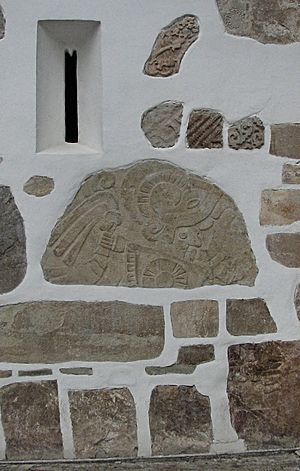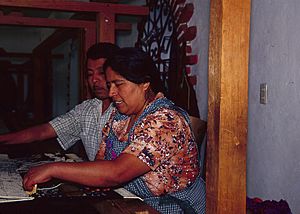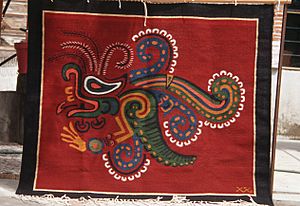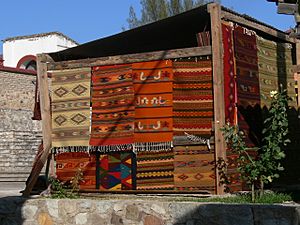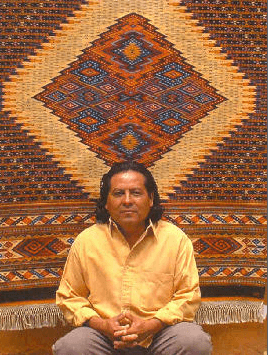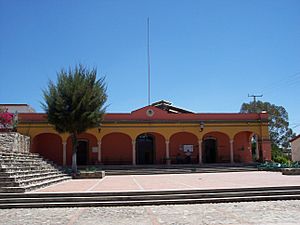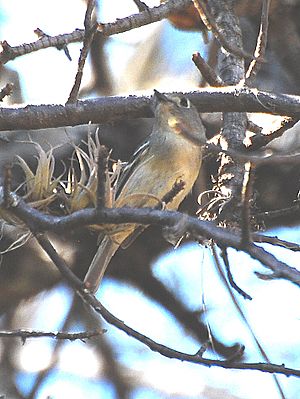Teotitlán del Valle facts for kids
Quick facts for kids
Teotitlán del Valle
Xaguixe
|
|
|---|---|
|
Town and municipality
|
|
| Country | |
| State | Oaxaca |
| Founded | 1465 |
| Area | |
| • Municipality | 81.54 km2 (31.48 sq mi) |
| Elevation | 1,670 m (5,480 ft) |
| Population
(2005)Municipality
|
|
| • Municipality | 5,601 |
| • Seat | 4,427 |
| Time zone | UTC-6 (Central (US Central)) |
| • Summer (DST) | UTC-5 (Central) |
Teotitlán del Valle is a small village and municipality in Oaxaca, Mexico. It is located in the Tlacolula Valley, about 31 km from the city of Oaxaca. The village is famous for its beautiful handmade textiles, especially rugs. These rugs are woven on special machines called looms. Weavers use wool from local sheep and color it with natural dyes from plants and insects.
The name Teotitlán comes from the Nahuatl language. It means "land of the gods." Its Zapotec name is Xaguixe, which means "at the foot of the mountain." The village was founded in 1465. It was one of the first places settled by the Zapotec peoples in this area. Today, Teotitlán del Valle still keeps its strong Zapotec culture and language.
Contents
History of Teotitlán del Valle
Teotitlán del Valle is thought to be one of the first villages founded by the Zapotec people. This happened around the year 1465. The original name of the village was Xaquija. This name means "celestial constellation."
According to research, there was a large stone split in half here. It was called the Stone of the Sun. This stone was the first idol, or sacred object, for the Zapotecs in this area. People believed that a god came from the sky as a bird. This god was with a group of stars when the temple was founded here.
Later, in 1527, Teotitlán del Valle was re-established as a Spanish village.
Exploring the Town
Teotitlán del Valle is a rural town. It has kept its Zapotec culture alive. In the local market, people gather early in the morning. They buy food and materials for crafts. Most people here still follow old customs. Many residents also speak the Zapotec language.
Important Buildings in Teotitlán
The two most important places in town are the Preciosa Sangre de Cristo Church and the Community Museum.
The Preciosa Sangre de Cristo Church is the main church. Its construction started in 1581. It was finally finished in 1758. The front of the church is made of stone called cantera. It has beautiful carvings around the main entrance. This church was built where a Zapotec temple once stood. The Spanish destroyed the temple and built the church in its place. You can still see parts of the old temple in the church's foundation. There is also a small archeological area next to the church. Inside, you can see old decorations from the 1500s. These designs have ancient Zapotec patterns. The church also has many old statues of saints. Many of these statues are colorful and well-preserved.
The community museum is called Balaa Xtee Guech Gulal. This means "in the shadow of the old village/people." The museum opened in 1995. A new part of the museum shows the Danza de la Pluma, or Feather Dance. The museum has signs in Spanish, English, and Zapotec.
It has three main rooms. One room is about the ancient history of the area. It has carved stones and pottery. Visitors can even touch some of the items. Some pieces show that the Olmec people visited here around 500 BCE. Another room is about crafts. It shows old photos, looms, and how wool is prepared. It also explains how dyes are made for textiles. The third room is about traditional weddings. It shows how the groom performs his duties. There is also a wedding mural.
Festivals and Traditions
The town's biggest festival is the Feast of the Precious Blood of Christ. It happens every year on the first Wednesday of July. The celebration lasts about a week. It has carnival rides and a basketball tournament. But the main event is the "Danza de la Pluma," or Feather Dance. In Zapotec, it is called Guyach. Dancers wear fancy headdresses made of painted feathers. This dance remembers when the Spanish conquered the Aztec people.
The town also has a tour service called Tourist Yú'ù. It helps visitors explore the area. You can visit the community museum and the archeological zone. You can also see the municipality dam and two natural spots. These spots are called Picacho and Cuevitas.
Local Food and Drinks
Some popular dishes here include mole negro and mole amarillo. You can also find liver with eggs and tamales. Tamales can be filled with mole, corn, cheese, or chicken. Popular local drinks are hot chocolate, atole, atole with pulque, and mezcal. You can try some of these at the famous restaurant Tlamanalli. It is run by Zapotec chef Abigail Mendoza Ruiz.
Teotitlán's Famous Textiles
The community is famous for its weavings. They are called “laadi” in the local language. Making textiles is the main way people earn money here. This village is known for its woven wool rugs. They often use natural dyes. For example, they use dye from the cochineal insect. These rugs can have old Zapotec designs. They can also have more modern patterns. Farming is another important way people make a living.
Weaving in this village started a very long time ago, at least 500 BCE. The first weavings used cotton and ixtle fibers. They were made on a simple backstrap loom. In the past, Teotitlán paid its taxes to the Aztecs with weavings.
More modern weaving methods came around 1535. A bishop named Juan López Dezárate brought sheep and new looms. These new looms were called treadle looms. With new materials and looms, weavers could make bigger items. They made rugs, serapes, and blankets. Over time, the village focused only on making rugs. They sold these rugs in markets in other towns.
In the late 1940s, the Pan-American Highway was completed. This connected the area to Mexico City, opening up new markets. In the 1950s, tourists started visiting Oaxaca by plane. They became interested in the local crafts. A famous Zapotec weaver was Arnulfo Mendoza. He owned Casa Serra Sagrada in Teotitlán. He also had a gallery in Oaxaca City.
The rugs are made by hand from wool. Most designs are woven from the artist's memory. Designs include Zapotec and Mixtec symbols. They also feature patterns from Navajo designs. Some rugs even copy famous paintings by artists like Picasso or Diego Rivera.
The process of making rugs starts with washing the raw wool. This removes dirt. Then, the wool is combed and spun into yarn. The yarn is rolled into large balls. After that, it is dyed using natural colors. These colors come from plants like indigo and Mexican Marigold. Some workshops also use chemical dyes. The looms used are operated by hand.
Both men and women weave in family workshops. Artisans of all ages help with the work. About 150 families are involved in weaving. Some families also specialize in making candles. One such workshop is Artesanía Casa Santiago. It has been on the town's main street since 1966. Many weavers also work in farming. But as more people want rugs, some spend more time weaving. These workshops even take special orders.
Many workshops allow visitors to come in. You can see how the rugs and other textiles are made. Some workshops now offer other items too. These include wall hangings, handbags, and pillow covers. They also make jackets, ponchos, and dresses.
The Municipality of Teotitlán
The town of Teotitlán del Valle is the main center for its municipality. A municipality is like a local government area. It includes nine other small communities. The total area of the municipality is 81.54 square kilometers. Out of 5,601 people in the municipality, 4,427 live in the main town.
The municipality is in the Central Valleys region of Oaxaca. It is 31 km from Oaxaca city. It sits at the base of the Sierra Juárez mountains. The main town is in a small flat area. The municipality shares borders with several other municipalities. These include Santa Catarina Lachatao and San Jerónimo Tlacochahuaya.
The area has several important hills. These are Gueliaa, Cerro Grande Quiea Less, and Dai-N Nizz. Rivers include the Grande and Gueu-Liaa. There is also a dam called Piedra Azul. The climate is mild, similar to Oaxaca city. The area has many types of trees. Wildlife includes different birds like falcons and owls. Small animals like opossums and rabbits also live here.
Most of the land in the municipality is used for farming. Almost all the food grown is for local families. About 68% of the people also make crafts. They mainly create wool rugs with Zapotec designs.
Nature and Activities
Many people who love birds come here to watch them. They especially like the area above the Piedra Azul Dam. They look for birds that live only in this dry region. These include the ocellated thrasher and the dwarf vireo. Other birds like the Oaxaca sparrow and gray-breasted woodpecker can also be seen.
Birds can also be seen at the Benito Juárez dam. This dam fills up during the rainy season in summer. The best time to see birds that migrate is from November to March. You might see herons and kingfishers then.
Besides birdwatching, you can do other activities in the mountains. These include hiking, horseback riding, and mountain biking. The two main natural attractions are El Picacho Peak and the Cuevita del Pedimento caves. El Picacho is also known as Cerro Gie Bets. This means “stone brother” in Zapotec. Both places are good for hiking. You need to get permission from the community museum to visit.
El Picacho is considered a sacred place. Its peaks offer a wide view of the Tlacolula Valley. The Cuevita del Pedimento is a group of three caves. People traditionally visit these caves on New Year's. They go to ask the image of the Virgin Mary there for good things in the coming year.
One special custom in this municipality is called tequio. This means doing administrative duties without getting paid. It is a type of community service. For example, being the municipal president is a full-time job for three years. People do this to help their community.


